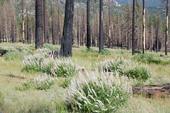- Author: Susie Kocher
The fourth winter in a row of disappointing precipitation has triggered a die off of trees in the Sierra Nevada, most of which is now in ‘exceptional drought' status. The US Forest Service conducted aerial monitoring surveys by airplane in April 2015 and observed a large increase in tree mortality in the Southern Sierra (from Sonora south). Surveyors flew over 4.1 million acres of public and private forest land and found that about 20 percent had tree mortality on it, totaling over 10 million dead trees.
The Forest Service found severe mortality in many pine species especially ponderosa pine. On private lands along the foothills of the Sierras, surveyors found extensive areas of dead pines. Large areas of blue and live oak...
- Author: Brook Gamble
Reprinted from the UCANR Green Blog
Over a dozen UC Agriculture and Natural Resources (UC ANR) California Naturalists, fire ecology experts, wildlife biologists, resource managers, educators, and artists met at UC Berkeley's Blodgett Forest Research Station and the adjacent
- Author: jeannette warnert
- Posted by: Susie Kocher
Published on: October 28, 2014 on the UCANR Green Blog
After academics complete fire science research, the results often end up gathering dust on a shelf. UC Cooperative Extension is now playing a significant role in bridging the gap between wildland fire science and wildland managers across the United States.
“It is a classic disconnect,” said Susie Kocher, UC Cooperative Extension advisor in the Central Sierra office. “That's why Cooperative Extension was formed almost 100 years ago. Policymakers could see that research...
- Author: Jeanette Warnert
- Posted by: Susie Kocher
Reprinted from the UCANR Green Blog
Every year, the day after Thanksgiving, Susie Kocher bundles up her children, gathers the extended family and hikes into the Lake Tahoe Basin forest to find a Christmas tree.
“It’s my favorite part of the season,” Kocher said. “Having the fresh, living thing in the house really...
- Author: Susie Kocher

In the many forested areas where wildfires are currently burning, the question will soon arise: What should be done after the fire goes out? That depends on the severity of the burn and land owner goals.
For high severity burns where very few or no live trees remain to provide seed for the next generation, forest recovery can take a very long time. Typically forest landowners want to restore their lands to a forested condition as quickly as possible. In that case, an active approach can help them reach...


